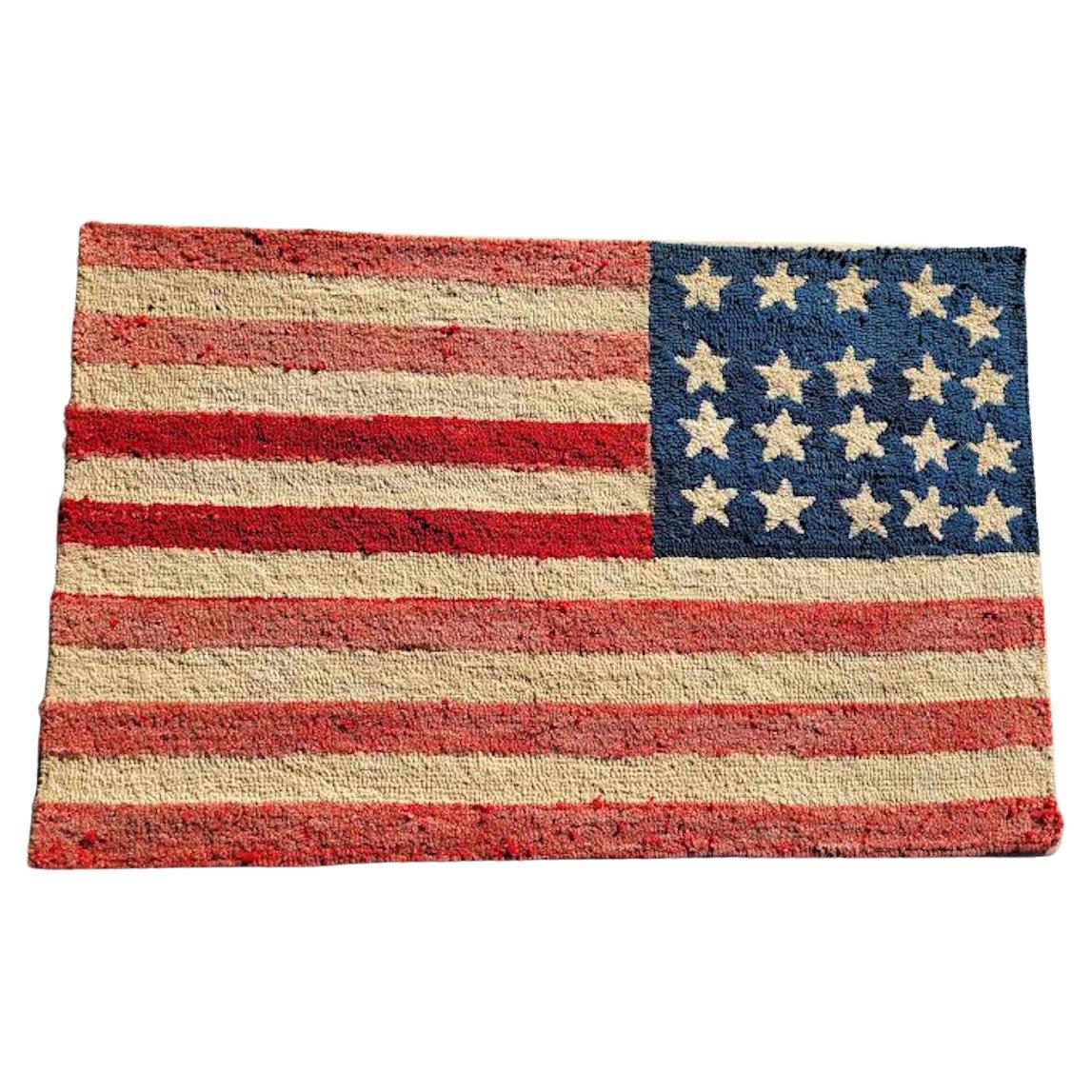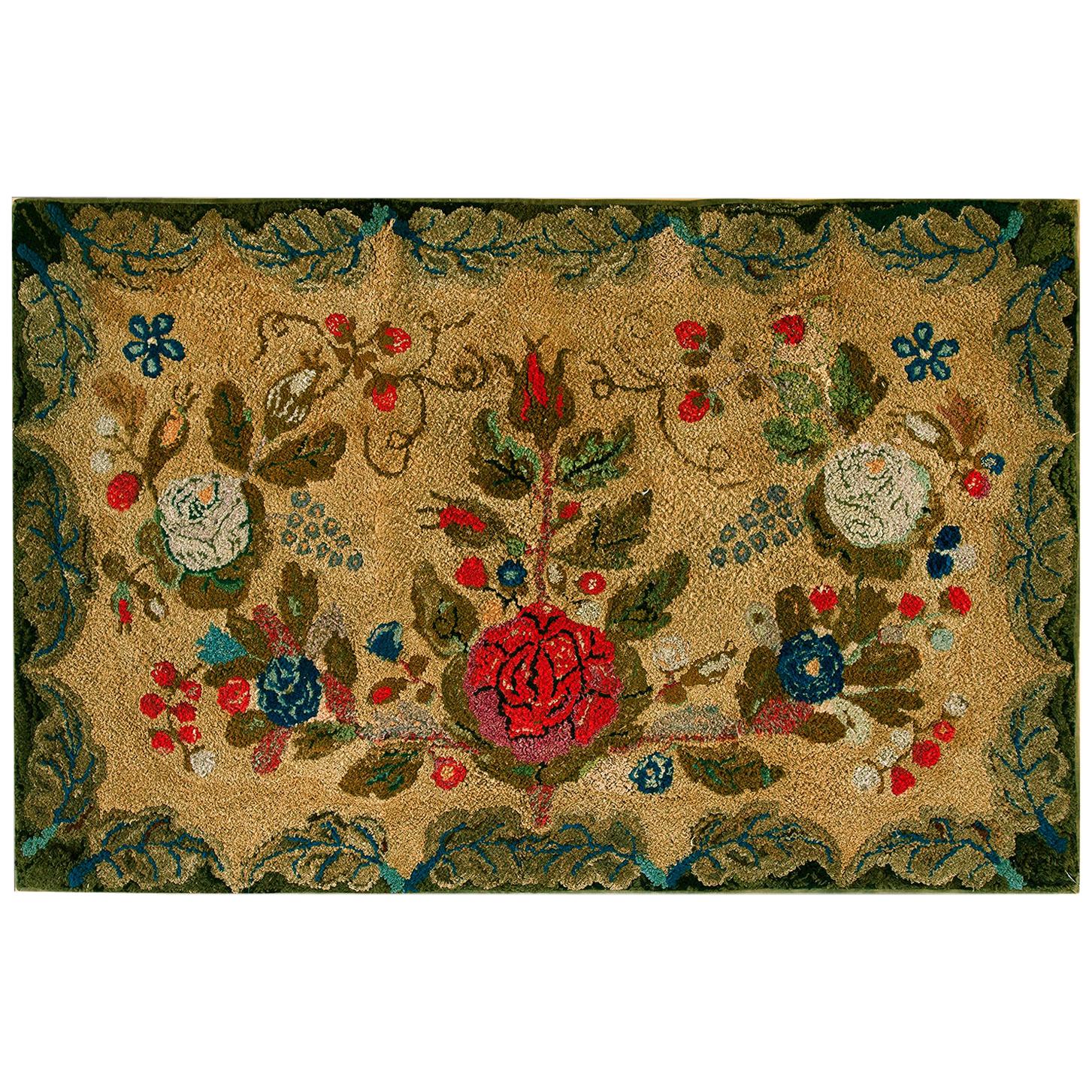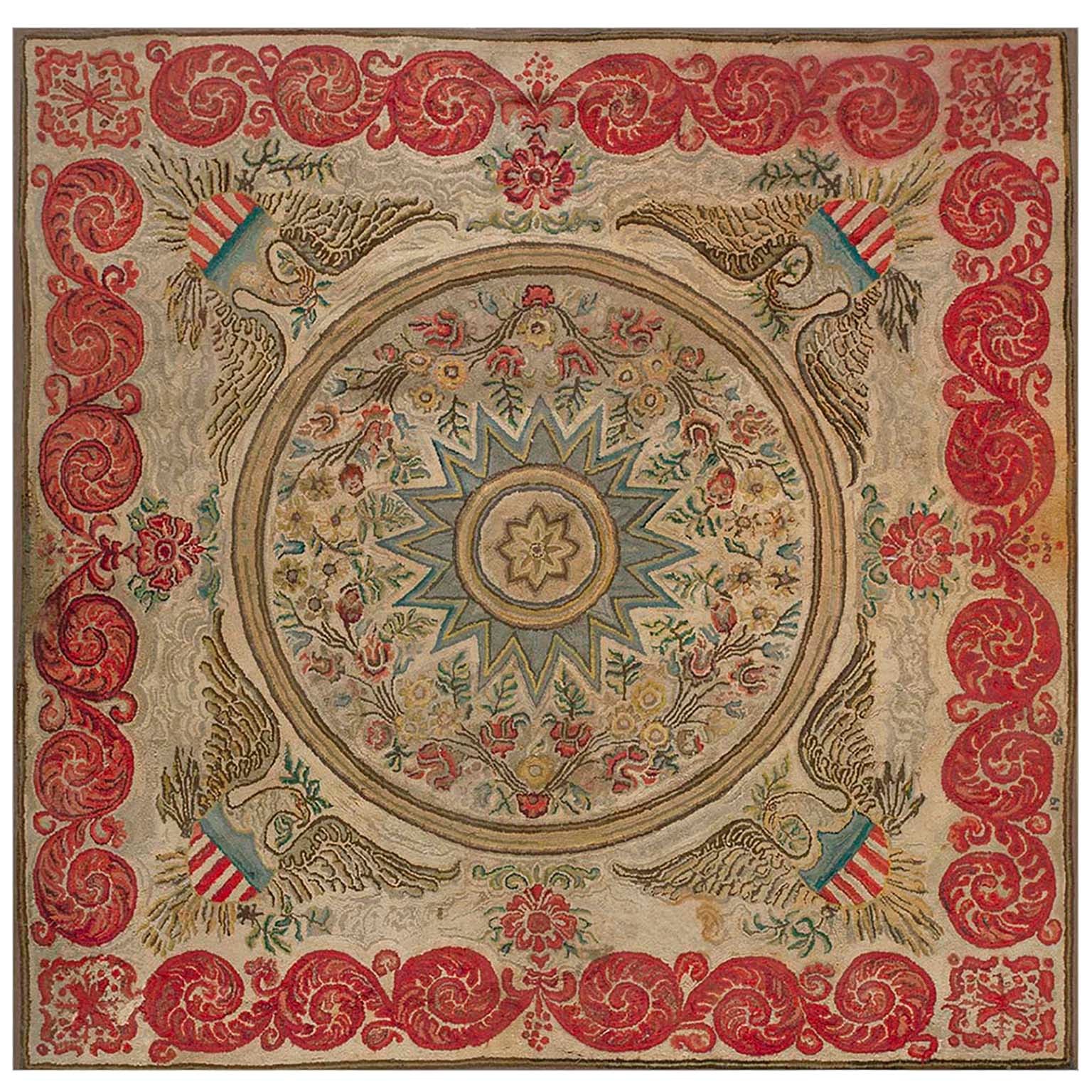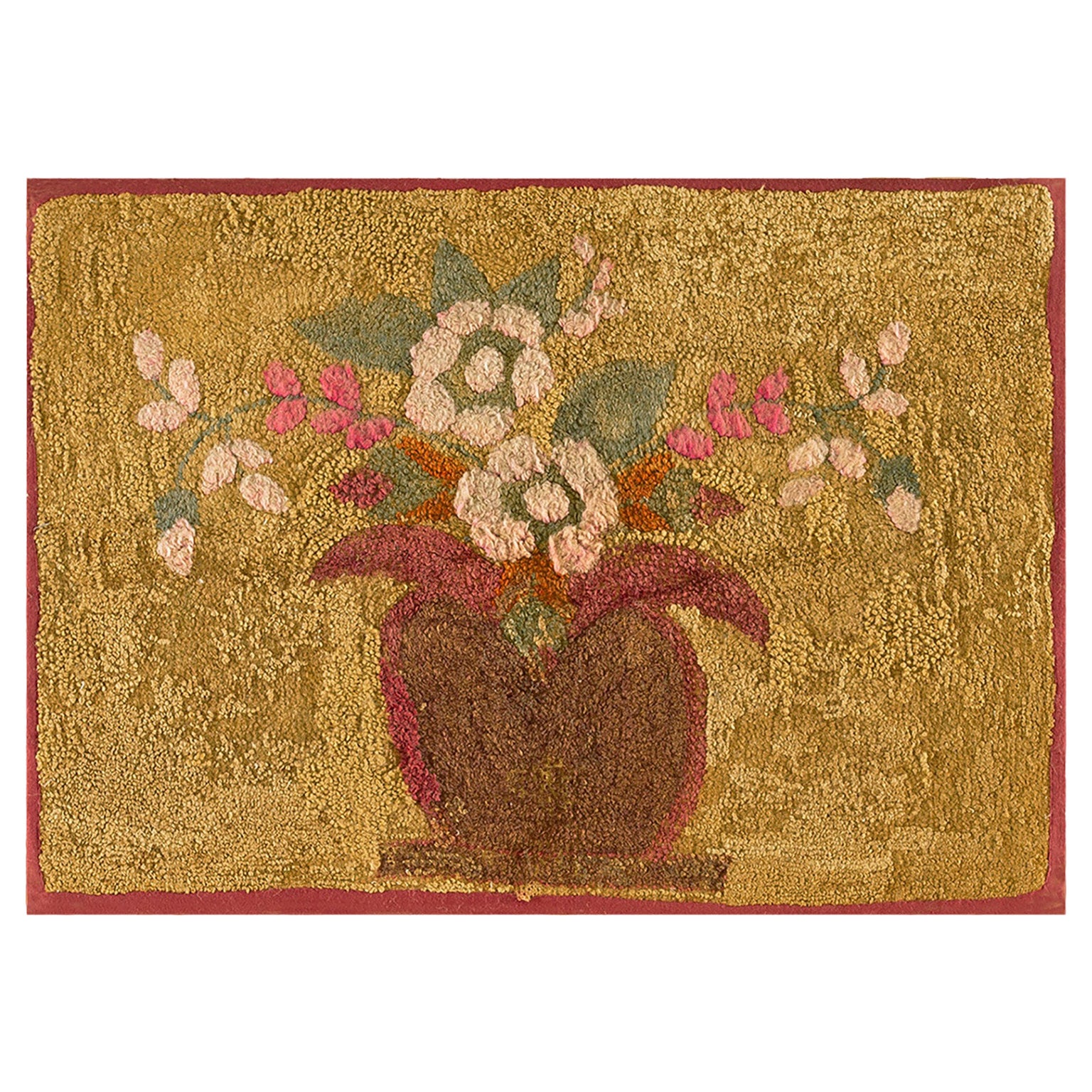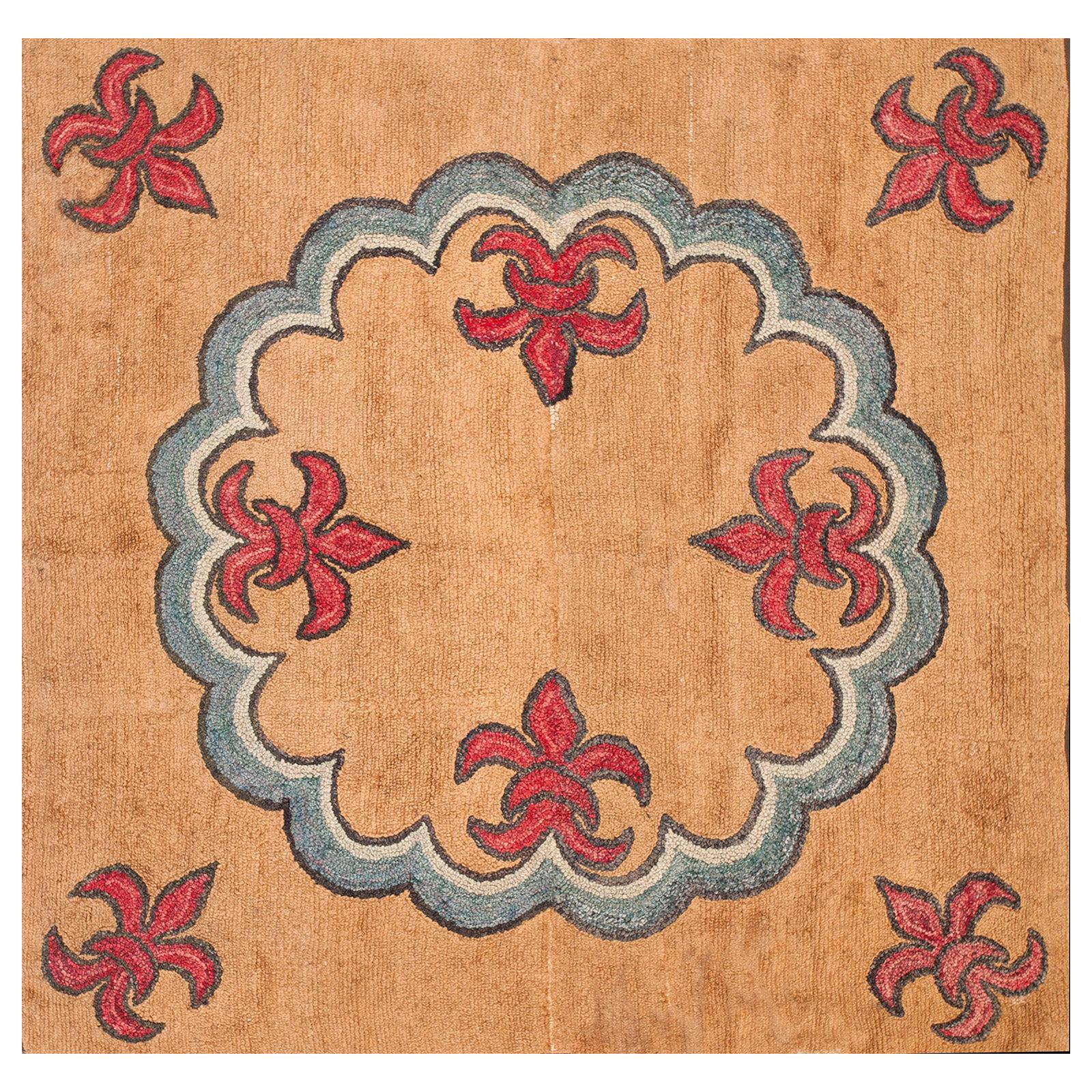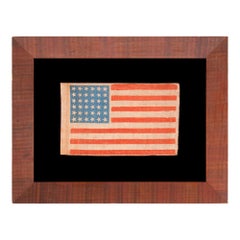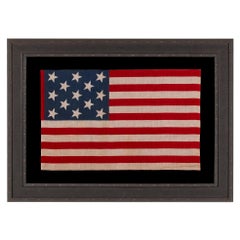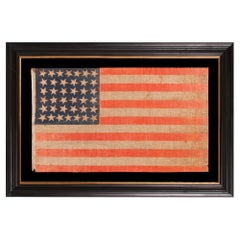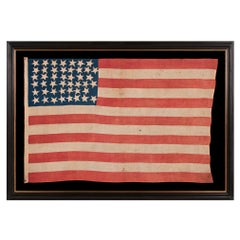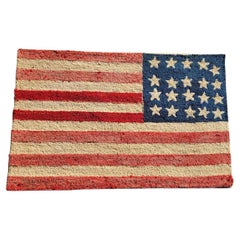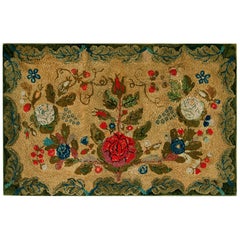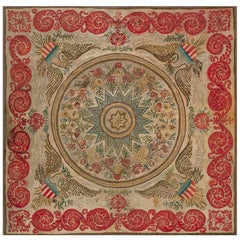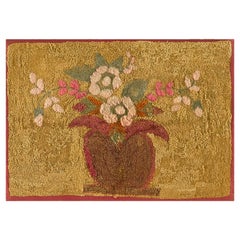Items Similar to "Don't Tread on Me" Hooked Rug, Ca 1880-1910
Want more images or videos?
Request additional images or videos from the seller
1 of 6
"Don't Tread on Me" Hooked Rug, Ca 1880-1910
Price Upon Request
Price Upon Request
Price Upon Request
Price Upon Request
Price Upon Request
Price Upon Request
Price Upon Request
Price Upon Request
Price Upon Request
Price Upon Request
About the Item
WOOL HOOKED RUG WITH A BILLOWING AMERICAN FLAG AND A FORKED TAIL STREAMER WITH THE “DON’T TREAD ON ME” SLOGAN; made Circa 1880-1910; THE 5 STAR COUNT, IF PURPOSEFUL, WOULD CELEBRATE THE NUMBER OF STATES THAT AFFORDED WOMEN THE RIGHT TO VOTE; EX-AMERICA HURRAH, ILLUSTRATED IN THEIR 1975 BOOK “HOOKED & SEWN RUGS”
Wool hooked rug with patriotic theme and beautiful design. Note the artistic quality of the waving American flag on a black staff, capped with a spear-shaped finial. Canted to the right, the billowing, red and blue, forked-tail streamer bears text that reads "Don't. Tread. On. Me .." The device is framed in a rectangular window with step-down corners. Bordered with a leaf and vine design, the presentation is at the same time antique and modernistic. This is accentuated by the creative, off-balance use of color around the perimeter, which seems to lean with the flag from the use of the tan, black, rust brown, and grey scraps of fabric, that probably reflects whatever remained available to the maker. The design demonstrates the influence of the early Arts & Crafts period, that began in the 1880’s and transitioned into Art Nouveau, which it strongly influenced.
The “Don’t Tread on Me” slogan was popular on early American flags of the Revolutionary War era. The most famous of these is the design attributed American Forefather Christopher Gadsden of South Carolina, with a coiled rattlenake on a yellow ground, that he created to serve as the Standard of the Commander In Chief Of The Continental U.S. Navy, followed by the mythicized “First Navy Jack,” with rattlesnake extending across field of red and white stripes, and the flag of the Culpepper Minutemen of Patrick Henry’s 1st Virginia Regiment of 1775, with a coiled rattlesnake on a white field. The interesting thing about the use of the accompanying motto is that it doesn’t seem to have been popular in the 19th century. Though flags in all three designs appear in an engraving for a historic flag display in the enormous "Main Building" at the Centennial International Exhibition in Philadelphia, the massive World’s Fair held in 1876 to celebrate 100 years of American independence, actual flags in these patterns were almost never produced, nor the motifs and slogan popularized, until the mid-late 20th century.
In waving images of the flag, the count of stars is often meaningless. Though it’s difficult to be sure, the count of 5 in this instance seems almost purposeful. If that is the case, a date of 1910 is a possibility. In this particular year, five states afforded women the right to vote. When examining the way the total was calculated, the situation can be a bit confusing. Some territories granted suffrage for elections prior to becoming states. In some cases, it was revoked, then reinstituted. The Wyoming Territory was the first to allow women to vote, in 1869, followed by the Utah Territory in 1870 (revoked in 1887, reenacted in 1895), the Washington Territory in 1883 (revoked in 1887, reenacted in 1910), and Colorado in 1893. While Idaho did, in fact, become the fifth state in 1896, Washington had revoked the right by this time, and did not reinstitute suffrage until 1910. Graphic depictions of American flags, altered for the Suffrage movement, seem to have no trouble in presenting the correct number of states. Some versions of a classic postcard illustrate a 13-stripe flag with 4 stars, listing Wyoming, Utah, Colorado, and Idaho, clearly excluding Washington, which basically got out of line, then back in, to become the fifth in 1910. When California adopted suffrage a year later, in 1911, flags were once again made to celebrate the event, celebrating its addition as the sixth state, by adding a sixth star. Though use of the “Don’t Tread on Me” motto is not known to have been common among the verbiage of the suffrage platform, it was certainly fitting, and it was, in fact, used. A terrific image of a parade in Washington, D.C., on March 3rd, 1913, illustrates a banner being carried by the Just Government League of Maryland, in the form of the flag in the design of the Culpepper Minutemen, with their name replacing that of the unit, along the top, above a coiled rattlesnake, flanked by the words “Liberty or Death,” with “Don’t Tread on Me” arched beneath. Clearly the words of colonial America in the Revolutionary War, were not lost on Maryland suffragettes. In addition, a calendar produced to advertise the Beneficial Insurance Company in 1903, shows a woman in a purple gown, on a green background—England’s suffrage movement colors—carrying a golden yellow Gadsden flag—the primary color of the movement in America. Typically illustrating Lady Columbia, the figure was changed to a Gibson girl-like image. Though suffrage is not specifically mentioned in the ad, the message of the firm is quite clear.
Whatever the case may be, with regard to the used of 5 stars, the composition and colors are the rug are wonderful, as-is the patriotic theme. The textile is a fantastic representation of American folk art in this medium.
Made of wool, the rug was constructed sometime between 1880 and 1910. This exact rug was illustrated on p. 66 of “American Hooked and Sewn Rugs” by Joel and Kate Kopp (America Hurrah Antiques), (1975, E.P. Dutton & Co, New York). The Kopps date the rug circa 1890.
Provenance: Joel & Kate Kopp (America Hurrah Antiques); Collection of Peter and Barbara Goodman (acquired in January of 1953).
Mounting: The rug was professionally mounted on black cotton twill. A custom, wooden framework was created for further support, and the background fabric was wrapped around it, so that approx. 1” of depth is visible around the outer edge.
Condition: A scattering of minor repairs constitute less than 1% of the composition.
- Dimensions:Width: 49.25 in (125.1 cm)Length: 39.25 in (99.7 cm)
- Materials and Techniques:
- Place of Origin:
- Period:
- Date of Manufacture:1880-1910
- Condition:See Item Description.
- Seller Location:York County, PA
- Reference Number:Seller: hkr-0471stDibs: LU849741564102
About the Seller
5.0
Recognized Seller
These prestigious sellers are industry leaders and represent the highest echelon for item quality and design.
Established in 1991
1stDibs seller since 2008
70 sales on 1stDibs
Typical response time: 5 hours
- ShippingRetrieving quote...Shipping from: York County, PA
- Return Policy
Authenticity Guarantee
In the unlikely event there’s an issue with an item’s authenticity, contact us within 1 year for a full refund. DetailsMoney-Back Guarantee
If your item is not as described, is damaged in transit, or does not arrive, contact us within 7 days for a full refund. Details24-Hour Cancellation
You have a 24-hour grace period in which to reconsider your purchase, with no questions asked.Vetted Professional Sellers
Our world-class sellers must adhere to strict standards for service and quality, maintaining the integrity of our listings.Price-Match Guarantee
If you find that a seller listed the same item for a lower price elsewhere, we’ll match it.Trusted Global Delivery
Our best-in-class carrier network provides specialized shipping options worldwide, including custom delivery.More From This Seller
View All36 Star Antique American Parade Flag, with Canted Stars, ca 1864-1867
Located in York County, PA
36 STAR ANTIQUE AMERICAN PARADE FLAG WITH CANTED STARS IN DANCING ROWS, ON A BEAUTIFUL, CORNFLOWER BLUE CANTON; CIVIL WAR ERA, NEVADA STATEHOOD, 1864-1867
36 star antique American f...
Category
Antique 1860s American Political and Patriotic Memorabilia
Materials
Cotton
Price Upon Request
13 Star Antique American Parade Flag, ca 1876-1899
Located in York County, PA
13 STAR ANTIQUE AMERICAN PARADE FLAG, WITH A 3-2-3-2-3 CONFIGURATION OF STARS, AN EXTREMELY SCARCE AND UNUSUALLY LARGE VARIETY, MADE circa 1876-1899
13 star American national parade...
Category
Antique Late 19th Century Canadian Political and Patriotic Memorabilia
Materials
Cotton
Price Upon Request
38 Star Antique American Parade Flag, Colorado Statehood, ca 1876-1889
Located in York County, PA
38 STAR ANTIQUE AMERICAN PARADE FLAG WITH JUSTIFIED ROWS OF 7-6-6-6-6-7 AND SCATTERED STAR ORIENTATION, MADE DURING THE PERIOD WHEN COLORADO WAS THE MOST RECENT STATE TO JOIN THE UNION, 1876-1889
38 star American national parade flag, printed on coarse cotton, possibly with flax content. One of the flag’s most interesting features is the wild sweep of the grain of the fabric, the warp and weft of which are anything but perpendicular.
The stars are arranged in justified rows of 7-6-6-6-6-7. This results in a secondary pattern that I commonly call a “box-in-a-box-in-a-box”, because of the way in which the seemingly haphazard arrangement creates three consecutive squares. Note how the stars point in various directions on their vertical axis, which adds a nice element of folk quality to the overall design.
Most parade flags in this star count have red stripes that lean heavily toward orange, with a vibrant, chromatic luster. This was common across printed flags produced between the 1850's and the 38 star period, phasing out in the last decade of the 19th century. Also note how the wear and patina contribute to an endearing presentation that displays its long-term use gracefully.
Colorado became the 38th state on August 1st, 1876. This was the year of our nation’s 100-year anniversary of independence. Per the Third Flag Act of 1818, stars were not officially added until the 4th of July following a state's addition. For this reason, 37 was the official star count for the American flag in 1876. In the latter 19th century, it became common to add stars before the respective state(s) had even entered the Union. No one cared what was official, not even the military, where the matter of practicality with regard to flags always seems to have outweighed regulations. In the private sector, commercial flag-making was a competitive venture. Few flag-makers continued to produce 37 star flags when their competitors had jumped the star count to 38. It is for this reason that 38 and 13 stars (to represent the original 13 colonies) are more often seen at the Centennial International Exposition, the six-month long World’s Fair, held in Philadelphia, that served as the nucleus of the national celebration.
Some makers of printed parade flags actually began to produce 39 star flags in 1876, in hopeful anticipation of the addition of two more Western Territories instead of one. The 39th state would not join the Union for another 13 years, however, when the Dakota Territory—thought to be coming as a single state—entered as two separate states on November 2nd, 1889. The 38 star flag generally fell out of production at that time, though it technically remained official until July 3rd, 1890.
President Ulysses S. Grant was in office when the first 38 star flags would have appeared. The list of presidents that served during the period when the 38 star flag was official include Rutherford B. Hayes, James Garfield...
Category
Antique Late 19th Century American Political and Patriotic Memorabilia
Materials
Cotton
Price Upon Request
Homemade, Antique American Flag with Exceptional Folk Qualities, 1896-1908
Located in York County, PA
HOMEMADE, ANTIQUE AMERICAN FLAG WITH A TINY CANTON RESTING ON THE 6TH STRIPE AND AN EXTREMELY FOLKY PRESENTATION OF 45 STARS IN A “NOTCHED” PATTERN THAT MIGHT BE UNIQUE TO THIS EXAMP...
Category
Antique 1890s American Political and Patriotic Memorabilia
Materials
Cotton
30 Star Antique American Parade Flag, Wisconsin Statehood, ca 1848-1850
Located in York County, PA
ANTIQUE AMERICAN PARADE FLAG WITH 30 STARS, THE ONLY KNOWN EXAMPLE IN THIS SIMPLE BUT EXTRAORDINARY STYLE, PRE-CIVIL WAR, OFFICIAL FOR JUST TWO YEARS, REFLECTS THE ADDITION OF WISCON...
Category
Antique Mid-19th Century American Political and Patriotic Memorabilia
Materials
Cotton
Price Upon Request
34 STAR AMERICAN FLAG, CIVIL WAR, 1861-63, KANSAS STATEHOOD, 2nd KY CAVALRY
Located in York County, PA
34 STAR ANTIQUE AMERICAN FLAG OF THE CIVIL WAR PERIOD (1861-63), IN A TINY SCALE AMONG PIECED-AND-SEWN FLAGS OF THE PERIOD, WITH A TRIPLE-WREATH CONFIGURATION, AN ELONGATED FORMAT, AND ENTIRELY HAND-SEWN; FOUND WITH A LETTER FROM JOHN W. RUDE OF THE 2ND KENTUCKY VETERAN VOLUNTEER CAVALRY (UNION):
34 star flag of the Civil War period with a variety of extremely desirable features, handed down with a letter written by John W. Rude on November 8th, 1864, while encamped with the Army’s 1st Brigade, 3rd Division, as a member of the 2nd Regiment of Veteran Volunteer Cavalry. Tiny in scale among pieced and sewn examples, the flag displays a star pattern that consists of a three consecutive wreaths, with a single star in the very center. Because it lacks a single star in each corner, outside the basic pattern—usually present in flags of this design made during the mid-late 19th century—this is something I classify as a “snowball medallion.” Entirely hand-sewn throughout, note the square format of the blue canton, with its beautiful, circular star arrangement, and how interesting this combination is when paired with the elongated format of the flag itself. The stars are double-appliqued, meaning that they are applied to both sides. These are fat in shape and inconsistent in size. Note how the lowest star in the outermost ring actually dips into the white stripe below.
Made of plain weave cotton, there is a narrow binding along the hoist, red in color, with three sets of cotton ties. Those at the top and bottom are made of fine, braided hemp or hemp and cotton cord, stitched into place, while the one in the center, looped around the binding and tied, is made of lightweight, twisted, cotton thread. Note how the 5th, 6th, and 7th red stripes are pieced from two lengths of cotton fabric, which reflects that the maker was being conscious of conserving available fabric.
In the 19th century, most flags with pieced and sewn construction were 8 feet long and larger. A six-footer was considered small. Even military battle flags, carried on foot, measured 6’ x 6.5’, which translates into approximately 7’ x 7.5’ after framing, about the size of an average quilt and larger than can comfortably fit on a wall in a house with 8-foot ceilings and average width baseboard. Flags smaller than this exist, but the smaller they get, the more unusual they are. At just 1.5’ x 3’, this is about as small as one will ever encounter in a sewn flag of the Civil War era.
The flag appears to have likely been hand-carried. I expect that it probably saw military use of some sort as a camp flag...
Category
Antique 1860s American Political and Patriotic Memorabilia
Materials
Cotton
You May Also Like
Folky 19th C American Reverse Flag Hand Hooked Rug
Located in Los Angeles, CA
This very folky reverse 20 stars hand hooked American Flag rug is on a stretcher frame.It is most unusual due to the reverse of the American flag and twenty stars contained.Minor fade throughout consistent with age and use. Minor fabric loss due to age as well.
This is such an Americana example of fine folk art and patriotic at the same time.
Ex. Charlie Hunter...
Category
Antique 1890s American Adirondack Rugs
Materials
Wool
$5,516 Sale Price
20% Off
19th Century American Hooked Rug ( 3' x 5'5" - 90 x 165 )
Located in New York, NY
19th Century American Hooked Rug ( 3' x 5'5" - 90 x 165 )
Category
Antique 1880s American Folk Art North and South American Rugs
Materials
Fabric, Wool
$5,625 Sale Price
25% Off
Early 20th Century American Hooked Rug ( 6' 8'' x 6' 8'' - 203 x 203 )
Located in New York, NY
Early 20th Century American Hooked Rug
5' 8'' x 7' 8'' - 203 x 203
Category
Vintage 1920s American Folk Art North and South American Rugs
Materials
Wool, Fabric
$3,225 Sale Price
86% Off
Early 20th Century American Hooked Rug ( 2'3" x 3'1" - 69 x 94 )
Located in New York, NY
Early 20th Century American Hooked Rug ( 2'3" x 3'1" - 69 x 94 )
Category
Vintage 1910s American Folk Art North and South American Rugs
Materials
Wool, Fabric
$1,050 Sale Price
25% Off
Early 20th Century American Hooked Rug ( 4'10" x 4'10" - 147 x 147 )
Located in New York, NY
Early 20th Century American Hooked Rug ( 4'10" x 4'10" - 147 x 147 )
Category
Early 20th Century American American Craftsman North and South American ...
Materials
Jute
$2,850 Sale Price
25% Off
Signed Vintage American Needlepoint Rug in Blue with Pictorial - Rug & Kilim
Located in Long Island City, NY
This 3x4 vintage needlepoint rug is a rare signed piece and pictorial design, handmade with wool circa 1960-1970.
On the Design:
Dominated by a bald eagle with its wings spread wid...
Category
Vintage 1960s American North and South American Rugs
Materials
Wool
More Ways To Browse
Don Green
Wool Hooked Rugs
Hooked Rug Border
1880 Fabric
Figural Rug
Colorado Used Furniture
Antique Hooked Rug Patterns
Folk Art Hooked Rugs
Green Hooked Rug
Red Star Line
War Rugs
Revolutionary War Antique
Art Nouveau Rug Blue
Antique Furniture South Carolina
Navy Flags
Star Finial
1910s Fabric Furniture
The Continental Furniture Company
